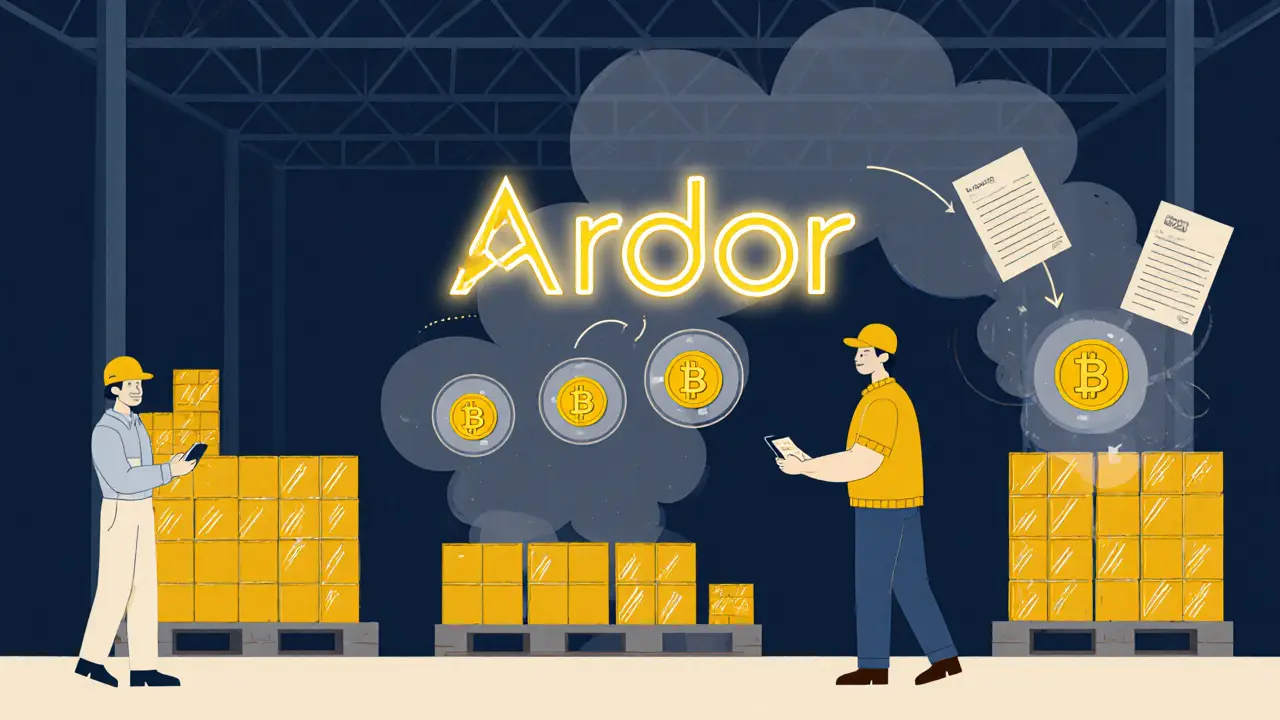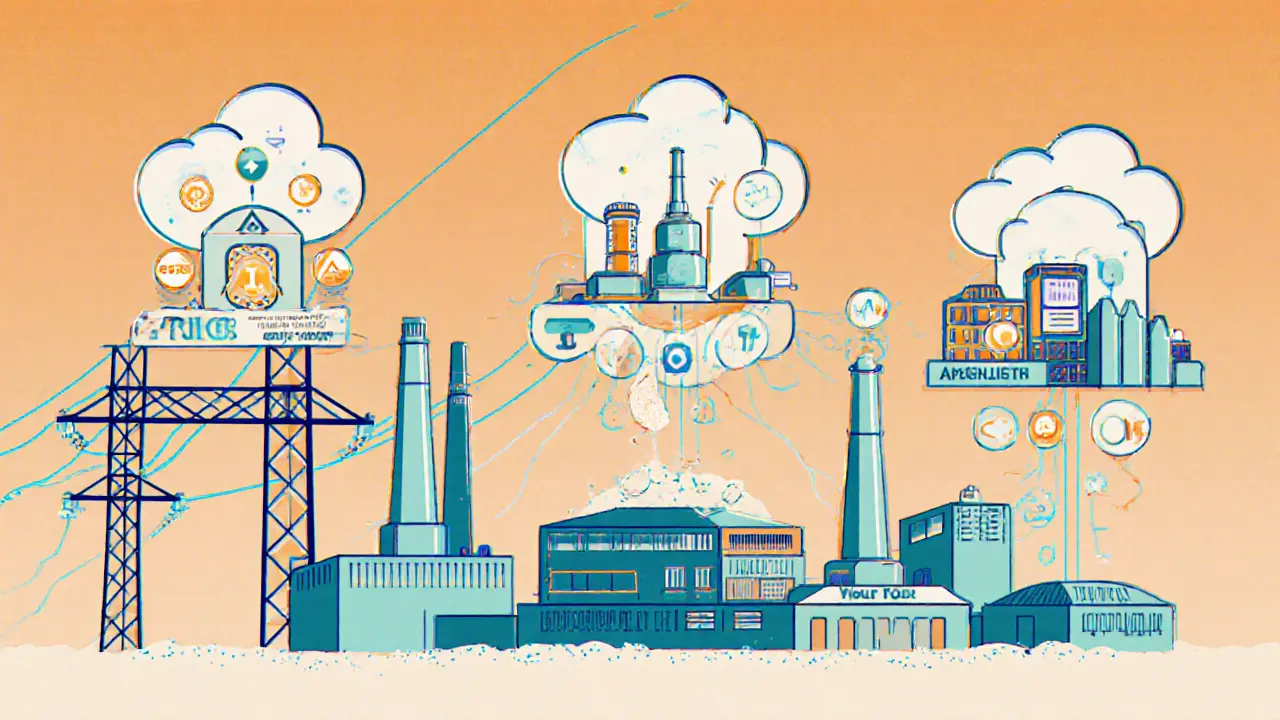Ardor (ARDR) Staking Calculator
Staking Calculator
Calculate your potential ARDR staking rewards based on current network parameters.
Important Note
Based on the article's information, 70% of ARDR tokens are actively staked, indicating strong network security. Current staking rewards are estimated at approximately 5-7% annualized (varies based on network conditions).
Staking Results
Estimated Rewards: 0.00 ARDR
Breakdown
How This Works
The ARDR token uses Proof-of-Stake (PoS) where validators earn rewards for securing the network. Your staked ARDR contributes to network security, and in return, you earn rewards proportional to your stake and the duration of your staking.
With over 70% of ARDR tokens actively staked, the network is secure and stable. Your staking not only generates returns but also helps maintain the security of the entire Ardor ecosystem.
Ardor (ARDR) isn't just another cryptocurrency. It’s a blockchain platform built to solve a problem most coins ignore: how do you scale blockchain technology for real businesses without turning it into a bloated, slow, and expensive mess? Launched in January 2018, Ardor separates security from functionality using a unique parent-child chain design. This means the main chain handles all the heavy lifting-consensus, security, and finality-while business-specific transactions run on lightweight, customizable child chains. The result? Faster, cheaper, and cleaner blockchain applications that don’t clog up the network.
How Ardor’s Parent-Child Architecture Works
Think of Ardor like a central power grid with individual factories plugged into it. The parent chain (Ardor) is the grid: it ensures everything stays secure and stable. Each child chain is a factory: it runs its own operations, issues its own tokens, and handles its own transactions-but it doesn’t need to build its own security system. It just taps into the parent chain’s protection.
This design solves the biggest headache in blockchain: bloat. Bitcoin and Ethereum keep adding every single transaction ever made to their ledgers. Over time, that makes nodes slower and harder to run. Ardor fixes this with pruning. Once a transaction on a child chain is confirmed and verified by the parent chain, the raw data can be safely deleted. Only a cryptographic hash remains on the main chain. This keeps the blockchain lean, even as usage grows.
Each child chain operates independently. For example, Ignis-Ardor’s first child chain-is used for asset issuance, voting, and decentralized exchanges. A company could launch its own child chain for loyalty points, supply chain tracking, or digital receipts. All of them benefit from the same security, but none interfere with each other’s speed or fees.
The ARDR Token: What It Does and Why It Matters
The ARDR token is the fuel of the entire Ardor ecosystem. Unlike many cryptocurrencies that have inflationary supplies, ARDR has a fixed total supply of 998,999,495 tokens. No more will be created. This scarcity is intentional-value is meant to grow as adoption increases.
ARDR isn’t used to pay for transactions on child chains. Instead, it’s used to pay for security. Every time a child chain processes a transaction, a small fee in ARDR is sent to the parent chain to cover the cost of securing that transaction. This creates a direct link between the platform’s usage and the value of the ARDR token.
ARDR runs on Proof-of-Stake (PoS), not mining. To earn rewards, you stake your ARDR tokens. The more you stake, and the longer you hold, the higher your chances of being chosen to validate blocks and earn fees. There’s no need for expensive hardware or massive electricity bills. You can stake from a regular laptop or even a smartphone.
According to Jelurida’s 2023 technical report, over 70% of all ARDR tokens are actively staked. That’s a strong signal of community confidence and network security. It also means the circulating supply of spendable ARDR is much smaller than the total supply-adding upward pressure on price if demand rises.
What Ardor Can Do That Other Blockchains Struggle With
Ardor isn’t trying to be Ethereum. It doesn’t aim to run thousands of DeFi apps or NFT marketplaces. Its strength is in enterprise-grade, specialized applications.
- Asset Issuance: Companies can create custom tokens for loyalty programs, coupons, or internal credits-all without needing to code a new blockchain.
- Decentralized Exchange: You can trade any child chain’s native token directly on the Ardor platform without leaving the ecosystem.
- Secure Messaging: Encrypted file and message transfers with built-in digital signatures. Useful for legal documents, medical records, or internal corporate communications.
- Voting Systems: Transparent, tamper-proof polls for shareholder votes, community decisions, or governance proposals.
- Marketplace: Buy and sell physical or digital goods using child chain tokens, settled in ARDR for security.
One European logistics firm built a supply chain tracker using Ardor’s Ignis child chain. They went from concept to live system in six weeks. On Ethereum, they estimated it would have taken six months-mostly because they’d need to manage smart contract audits, gas fees, and node infrastructure themselves.

How Ardor Compares to Alternatives
Here’s how Ardor stacks up against other platforms:
| Feature | Ardor | Ethereum | Hyperledger Fabric | Bitcoin |
|---|---|---|---|---|
| Consensus Mechanism | Proof-of-Stake | Proof-of-Stake (post-Merge) | Practical Byzantine Fault Tolerance | Proof-of-Work |
| Scalability | High (parallel child chains) | Medium (Layer 2 needed) | High (private networks) | Low (~7 TPS) |
| Blockchain Bloat | Solved via pruning | Severe issue | Managed via private nodes | Severe issue |
| Transaction Fees | Low, fixed in ARDR | Variable, network-dependent | Customizable, often zero | Variable |
| Developer Ecosystem | Small, enterprise-focused | Massive (4,000+ dApps) | Enterprise-only | Very limited |
| Best For | Businesses needing secure, customizable chains | DeFi, NFTs, general dApps | Private enterprise networks | Store of value |
Ardor wins on efficiency and cost for businesses that don’t need a public, open dApp ecosystem. It loses on visibility and developer tools compared to Ethereum. But for companies that want to avoid the complexity of Ethereum’s gas fees and smart contract risks, Ardor is a quiet, powerful alternative.
Who Uses Ardor? Real-World Examples
Ardor isn’t flashy. It doesn’t have celebrity endorsements or viral NFT collections. But it’s quietly being used in real business settings:
- A German logistics company uses an Ardor child chain to track pallets across borders. Each scan is recorded on-chain, and old data is pruned to keep costs low.
- A nonprofit in the Netherlands runs a transparent donation voting system on Ignis. Donors can see how funds are allocated, and votes are immutable.
- A digital marketing agency in Canada issues branded tokens to clients for campaign rewards-all built on a private Ardor child chain with zero transaction fees for end users.
These aren’t theoretical projects. Jelurida’s 2022 annual report confirmed “dozens of live enterprise implementations.” Most aren’t publicized because they’re internal tools-not consumer apps. That’s the point. Ardor is built for behind-the-scenes efficiency, not TikTok fame.
Challenges and Criticisms
Nothing’s perfect. Ardor has real drawbacks:
- Low visibility: ARDR ranks around #587 on CoinMarketCap. Ethereum is #2. Most people have never heard of Ardor.
- Steeper learning curve: Documentation is thorough but technical. If you’re not familiar with NXT (Ardor’s predecessor), the learning curve feels steep.
- Centralization risk: Critics argue that because all security depends on the parent chain, if the parent chain fails, everything fails. Jelurida counters that the parent chain is secured by thousands of stakers and has never been compromised.
- Limited exchange access: ARDR is listed on only 37 exchanges. Ethereum is on over 100. That makes buying and selling harder for casual investors.
One Reddit user summed it up: “I built a supply chain app on Ardor in three weeks. But trying to explain it to my crypto friends? That took three months.”

Is Ardor Worth Paying Attention To?
If you’re an investor looking for the next Bitcoin or Ethereum, Ardor might seem too quiet. Its price has hovered between $0.05 and $0.12 since early 2023, down from its all-time high of $2.03 in January 2018.
But if you’re a business owner, developer, or tech investor who cares about practical blockchain use cases, Ardor is one of the few platforms that actually solves a real problem. It doesn’t just promise scalability-it delivers it through clean, tested architecture.
The enterprise blockchain market is projected to hit $11.2 billion by 2025. Right now, most companies choose Microsoft Azure Blockchain or Hyperledger Fabric. Ardor offers a decentralized, open-source alternative with lower costs and no vendor lock-in.
Its fixed supply, proven pruning system, and enterprise adoption make it a quiet contender. It won’t trend on Twitter. But if you’re building something that needs to be secure, scalable, and cost-efficient? Ardor might be the tool you didn’t know you needed.
Getting Started with Ardor
You don’t need to be a blockchain expert to use Ardor. Here’s how to begin:
- Get an Ardor wallet: Download the official Ardor wallet from jelurida.com. It supports desktop and mobile.
- Buy ARDR: Trade Bitcoin or Ethereum for ARDR on exchanges like Bitvavo, HitBTC, or Mercatox.
- Stake your ARDR: Use the wallet to delegate your tokens to a validator. You’ll earn rewards monthly.
- Explore child chains: Use the Ignis wallet to issue assets, vote, or send encrypted messages.
For developers: Ardor is built in Java. If you know Java or have experience with APIs, you can start building child chains in under two weeks. Jelurida’s GitHub has full documentation, SDKs, and sample code.
Is Ardor (ARDR) a good investment?
Ardor isn’t a speculative play like many meme coins. Its value is tied to real enterprise adoption. If businesses start using it for supply chain tracking, loyalty programs, or voting systems, demand for ARDR could rise. But with low market visibility and limited exchange listings, it’s a long-term, niche bet-not a quick profit. Only invest what you’re comfortable holding for years.
Can I mine Ardor (ARDR)?
No, Ardor uses Proof-of-Stake, not mining. You can’t earn ARDR by running hardware. Instead, you stake your existing ARDR tokens to help secure the network and earn rewards. This is more energy-efficient and accessible to regular users.
How is Ardor different from Ethereum?
Ethereum is a single blockchain where everyone runs smart contracts on the same network. This causes congestion and high gas fees. Ardor uses multiple child chains-each handles its own transactions, so one busy chain doesn’t slow down others. Ardor also prunes old data, keeping the blockchain small. Ethereum doesn’t do that.
Is Ardor secure?
Yes. The parent chain is secured by over 70% of ARDR tokens being staked, making it very hard to attack. Child chains inherit this security without needing their own validators. The platform has been live since 2018 with no major breaches. However, because it’s less known, it’s not as battle-tested as Bitcoin or Ethereum.
Can I use Ardor for my business?
Absolutely. Ardor was built for businesses. If you need a secure, customizable blockchain for asset tracking, voting, loyalty programs, or internal record-keeping, Ardor lets you build a child chain without handling security, node maintenance, or blockchain bloat. Jelurida offers professional support for enterprise clients.
Where can I buy ARDR?
ARDR is available on exchanges like Bitvavo, HitBTC, Mercatox, and P2PB2B. It’s not on Coinbase or Binance, so you’ll need to use a smaller exchange. Always check fees and liquidity before trading.
What’s the future of Ardor?
Jelurida continues to develop Ardor with quarterly updates. Current focus areas include improving cross-chain communication and increasing transaction throughput across child chains. The biggest hurdle isn’t technology-it’s awareness. If Ardor gains more exchange listings and enterprise partnerships, it could grow significantly. Without that, it will remain a quiet tool for niche use cases.
Next Steps
If you’re a developer, start with the Ardor GitHub repo and build a simple child chain. If you’re an investor, monitor enterprise adoption news and watch for new exchange listings. If you’re a business owner, request a demo from Jelurida-many use cases can be prototyped in under a month.
Ardor doesn’t shout. But in a world of noisy blockchains, sometimes the quietest ones are the most reliable.
